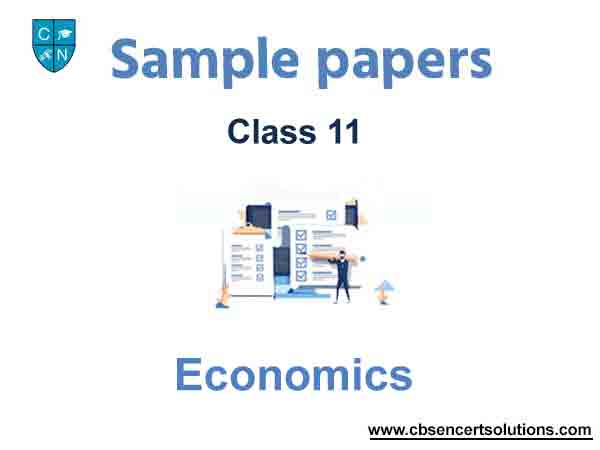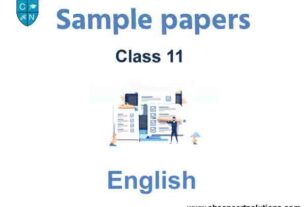Please refer to Class 11 Economics Sample Paper Term 2 With Solutions Set A provided below. The Sample Papers for Class 11 Economics have been prepared based on the latest pattern issued by CBSE. Students should practice these guess papers for class 11 Economics to gain more practice and get better marks in examinations. The Term 2 Sample Papers for Economics Standard 11 will help you to understand the type of questions which can be asked in upcoming examinations.
Term 2 Sample Paper for Class 11 Economics With Solutions Set A
Section A
Statistics for Economics
Case Based MCQ
Analyse the following case study graphs carefully and answer the question no. 1 to 5 on the basis of the same.

1. Coefficient of correlation has how many degrees?
(a) 4
(b) 5
(c) 3
(d) 6
Answer
B
2. Figure 3 represents ………… correlation.
(a) positive
(b) perfect positive
(c) negative
(d) perfect negative
Answer
A
3. What will be the degree of coefficient of correlation if Rxy is 0.75?
(a) High degree of positive correlation
(b) Moderate degree of positive correlation
(c) Low degree of positive correlation
(d) Perfect positive correlation
Answer
A
4. Karl Pearson’s coefficient of correlation can be calculated using …………… .
(a) assumed mean
(b) median
(c) Both (a) and (b)
(d) None of these
Answer
A
5. If the degree of correlation is 0.03, the series show ……… degree of ……… correlation.
(a) high, positive
(b) low, positive
(c) high, negative
(d) low, negative
Answer
B
Short Answer Type Questions
6. “Correlation is preferred to covariance as a measure of association.” Explain
Ans. Both, correlation coefficient and covariance measure the degree of linear relationship between two variables, but correlation coefficient is generally preferred to covariance. It is due to the following reasons
(i) The correlation coefficient has no unit.
(ii) The correlation coefficient is independent of origin as well as of scale.
(iii) The correlation coefficient suggests cause and effect relationship between different variables.
Or
“There are some pre-requisites of a good index number.” Defend.
Ans. Pre-requisites of an ideal index number are as follows
(i) It should be a composite calculation i.e., consider every type of items.
(ii) It should facilitate international comparision.
(iii) It should be rigidly defined.
7. Calculate standard deviation from the following data

Ans. Let assumed mean be (A) = 30

8. Calculate simple average of price relative from the following data

Ans.


Or
Compute Laspeyre’s index from the following data

Ans.

9. The following information is given regarding series X and Y. Compute coefficient of correlation.

Ans. We are given that,
Number of items (n) = 15
Standard Deviation of X (σx ) = 3.01
Standard Deviation of Y (σy ) = 3.03
Sum of products of deviations of X and Y from their respective means (∑xy) = 120
Coefficient of Correlation (r ) = ∑xy / n.σx .σy = 120 / 15 x 3.01 x 3.03 = 120 / 136.80 = 0.88
It is a indicative of high degree of positive correlation.
Section B
Introductory Microeconomics
10. “There exists a unique relationship between Average Variable Cost (AVC) and Marginal Cost (MC).” Comment.
Ans. Relationship between AVC and MC
(i) AVC and MC starts from same point and are ‘U’ shaped.
(ii) When MC < AVC, AVC falls.
(iii) MC = AVC, at the minimum point of AVC.
(iv) When MC > AVC, AVC rises.

Or
Do you agree with the view that TP increases even when MP is decreasing?
Ans. Yes, TP increases even when MP is decreasing, because MP is an addition to TP. When MP is decreasing, only an addition to TP is decreasing i.e. TP continues to increase, though at a diminishing rate. TP starts declining only when MP becomes negative.
Long Answer Type Questions
11. (i) Can Marginal Revenue (MR) be negative? Explain your answer with the help of example.
(ii) Total Revenue (TR) of a firm, dealing in a particular commodity, initially was Rs 15,000. It reduces to Rs 13,500. Also, AR increases from Rs 150 to Rs 270. Find the change in market demand for that commodity.
Ans. (i) Yes, Marginal Revenue (MR) can be negative. It can be negative only when average revenue is decreasing or when the price is declining as under monopoly and monopolistic competition. This can be explained by the following example
When price = Rs 20, output = 50
Total revenue of 50 units (TR 50) =P × Q= 20 × 50 = Rs 1,000
When price fall to Rs 19, output = 51
Total revenue of 51 units (TR 51) = P × Q= 19 × 51 = Rs 969
MR 51 = TR 51 – TR 50 = 969 −1,000 = Rs (31)
i.e., Marginal Revenue (MR) is negative.
(ii) TR = Rs 15,000, P(= AR) = Rs 150
TR = P × Q ⇒ Q = TR / P = 15000 / 150 = 100 units
When TR = Rs 13,500, P(= AR) = Rs 270
TR = P × Q ⇒ Q = TR / P = 13500 / 270 = 50 units
Change in market demand = 50 −100 = −50 units
i.e., market demand falls by 50 units
Or
State whether the following statements are true or false. Give reasons for your answer.
(i) When Marginal Revenue (MR) is constant and not equal to zero, then Total Revenue (TR) will also be constant.
(ii) As soon as Marginal Cost (MC) starts rising, Average Variable Cost (AVC) also starts rising.
(iii) Total Product (TP) always increases whether there is increasing returns or diminishing returns to a factor.
Ans. (i) False, because when Marginal Revenue (MR) is constant, Total Revenue (TR) is increasing at a constant rate, only when marginal revenue is zero, total revenue is constant.
(ii) False, Average Variable Cost (AVC) can fall even when Marginal Cost (MC) starts rising. See Average Variable Cost (AVC) and Marginal Cost (MC) corresponding to output range (MQ) in the diagram.
(iii) True, because in a situation of increasing returns to a factor, marginal product tends to rise accordingly, Total Product (TP) should be increasing at an increasing rate. Under diminishing returns to a factor, Marginal Product (MP) tends to fall. Falling Marginal Product (MP) implies that Total Product (TP) should be increasing, though at a decreasing rate.

12. Explain the effect of decrease in supply when
(i) demand is perfectly elastic
(ii) demand is perfectly inelastic
Ans. The effect of decrease in supply when
(i) Demand is Perfectly Elastic Decrease in supply of commodity does not cause any change in its price in case demand for the commodity is perfectly elastic. Only equilibrium quantity tends to change.

Demand is infinite at existing price. So, decrease in supply does not cause any change in price.
(ii) Demand is Perfectly Inelastic Decrease in supply of commodity causes rise in price and equilibrium quantity remains constant when demand for commodity is inelastic.

Demand is constant at every price. So, decrease in supply does not cause any change in price.
13. State the law of supply, the assumptions on which it is based and exceptions to the law of supply.
Ans. Law of supply derives the relationship between price and quantity supplied. According to this law, quantity supplied of a commodity is directly related to the price of a commodity, provided all other determinants are constant. The quantity supplied increases with increase in price and vice-versa.
Assumptions of the Law of Supply
The various assumptions of the law of supply are given below
(i) There is no change in the price of the factors of production.
(ii) There is no change in the techniques of production.
(iii) There is no change in the goal of the firm.
(iv) There is no change in the price of related goods.
Exceptions to the Law of Supply
The following are the exceptions to the law of supply (any four)
(i) Agricultural Goods Law of supply does not apply for agricultural goods, as their supply depends on climatic conditions and not on price.
(ii) Perishable Goods Perishable goods like fruits, vegetables, milk and milk products cannot be held for long. Therefore, suppliers are willing to supply these products, even when prices are less, for fear that they would become totally useless.
(iii) Antique Goods, Rare Articles and Paintings These goods are highly priced, but still their supply is limited, as supply here is affected by factors other than price. e.g., the supply of Hussain’s paintings cannot be increased even if buyers are willing to pay high price for it.
(iv) Future Expectations regarding Prices If prices are rising, but sellers anticipate that they would rise further in future, then they would not increase their supply now.
(v) Lack of Resources In underdeveloped or backward economies, supply cannot be increased due to lack of resources.
(vi) Labour Market In the labour market, it is observed that as the wage rate rises, the workers tend to work for less hours, so as to enjoy more leisure. This causes the supply of workers to decrease at increased wage rate.
Or
“Law of variable proportion in terms of marginal product gives another law known as law of diminishing marginal product.” Explain this law by giving schedule and graph.
Ans. Law of diminishing marginal product states that with the increase in a variable factor, keeping all other factors constant, the marginal product of the variable factor diminishes after a certain level of production and eventually becomes negative. This law was given by classical economists and related to agriculture.
This law may be explained with the help of an imaginary schedule and diagram


Note Law of diminishing marginal product operates in the second stage of law of variable proportion.
In the above diagram, after point ‘a’ on MP curve, marginal product diminishes continuously, showing the law of diminishing marginal product, i.e., with the employment of 6th labour, diminishing returns operates.
14. (i) How a firm is a price taker in perfect competition?
(ii) Why does it earns only normal profits in long-run?
Ans. (i) A firm under perfect competition, is a price taker, not a price maker because of the following three reasons
(a) Large number of buyers and sellers. (b) Homogeneous product. (c) Perfect knowledge.
(ii) A firm under perfect competition earns only normal profits in the long-run. This is because if the firms earn abnormal profits, then this would lead to increase in market supply because of entry of new firms thereby causing the market price to fall upto the level of normal profits.
On the other hand, if the firms earn abnormal losses, then this would force some marginal firms to exit from the market, causing market supply to fall. This will cause the market price to rise upto the level of normal profits.
Or
At a given price of a commodity there is ‘excess supply’. Is this the equilibrium price? If not, how will the equilibrium price be reached?
Ans. Equilibrium price refers to the price at which market demand is equal to market supply (i.e., there is no excess demand or excess supply). So, the price with ‘excess supply’ is not the equilibrium price.
This can be illustrated with the help of the following figure

The given figure depicts, that excess supply is equal to AB = Q1Q2 It implies that market supply is greater than market demand.
This puts pressure on price (OP1 ) to decline. The producers reduce the quantity supplied at the lower price OP from OQ2 to OQ. The consumers react by increasing the quantity demanded from OQ1 (at OP1 price) to OQ (at OP price). Equilibrium is struck at point ‘E’. Thus, OP and OQare the equilibrium price and equilibrium quantity respectively with no excess supply.



